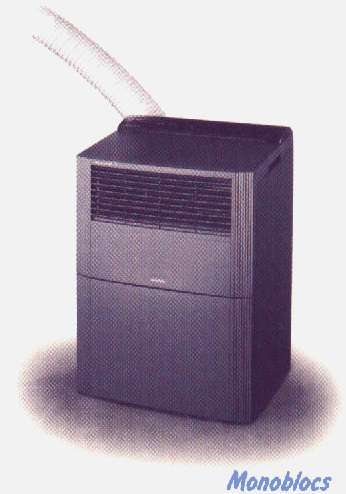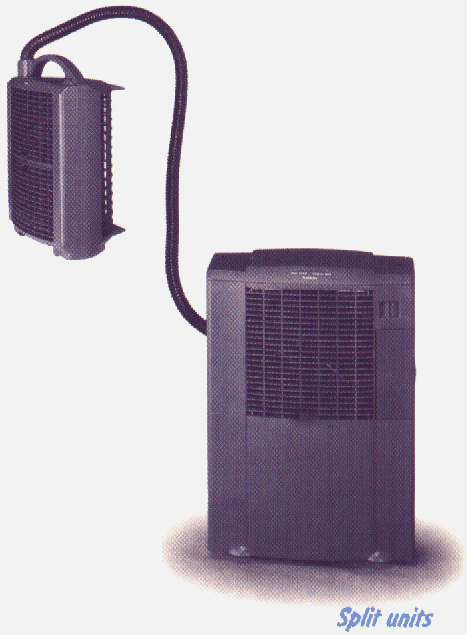The Different
Types of Portable Air conditioning Unit
There are two types
Portable air conditioner units.
Air to Air: Warm
air from the room passes over the evaporator which will then release cold air.
The captured heat is given to more air passing over the condenser and is
expelled outside the room via a mobile air conditioner hose. Most air to air air
conditioners do not need any intervention from the user, nor do they have
scaling problems, or stagnant water problems.
2 Air to Water:
The air is chilled by passing directly over the evaporator, but instead of using
only air to transport the captured heat from the condenser, water is also used
to cool the condenser. The use of this product is limited as the water tank
needs to be filled The operating time is reduced to between 4 and 6
hours.
Mobile air
conditioning units also come in two styles
|
|
|
| 1 Monoblocs air conditioner: This
is a one piece unit working on an air to air principle. Warm air from the
room passes over the evaporator and is chilled before being blown back
into the room. More air passing over the condenser absorbs the captured
heat and it is expelled outside the room via a hose. This hose must be
vented through an outside wall or window using the socket provided. As a
temporary instant solution, a flattened adaptor is included so that the
hose can be fitted through a partially opened window or door. Extra
exhaust sockets can be installed, so that your air conditioner can be
moved between rooms. |
2 Split air conditioning units:
Here the condenser and the evaporator are split into two units and work on
an air to air principle. Warm air is drawn into the unit and cooled by
being passed directly over the evaporator before being blown back into the
room. The mobile split air conditioner unit has a greater efficiency
because the captured heat is circulated through the condenser situated
outside.The separate external (condenser) box is connected to the main
inside unit by means of refrigerant lines. These lines can be
disconnected, so they can be passed through a hole in the wall, about the
size of half a brick before reconnecting. The external box can be placed
either on the ground outside, a window sill or balcony, or be hooked on
straps over the edge of a window frame or attached to the outside wall on
the bracket supplied. However, the unit is less mobile and has to be near
a window or other outside opening. |
 |
 |
Choosing the
right unit portable air conditioning unit
Measuring the
performance...
There are two ways of
measuring the cooling performance of air conditioners BTU and Watts. All air
conditioners also have a dehumidification function which is measured by the
number of litres of water per hour that can be extracted from the air by the
portable air conditioner unit.
Room
Sizing...
| You can work out
your BTU requirement by measuring the size of the room you need to cool.
The effectiveness of the unit is dependent on various other factors such
as the level of sunshine, the level of insulation, ventilation, the number
of people and the amount of electrical equipment in the room. To work out
your cooling requirement, measure the cubic capacity of the room you wish
to cool. Average ceiling height is 2.75metres. Width and length can be
measured by pacing. Then multiply the figure cubic feet by 4 for BTUs and
cubic metres by 40 for watts. |
|
For example:
|
Imperial
| Height |
8
feet |
Therefore room size is 8 x 16 x
12 1536 cubic feet. 1536 x 4 =6144BTU |
| Length |
16
feet |
| Width |
12
feet | |
 |
Metric
| Height |
2.5m |
Therefore
room size is 2.5 x 5.0 x 3.7 - 46.25 cubic metres 46.25 x 40
=1850Watts |
| Length |
5.0m |
| Width |
3.7m | |
These
measurements account for a room with three or four people, a PC and a
photocopier. For each extra person or PC add 120 Watts.
As a sirnple guide to
your requirements just calculate the square footage of your room and refer to
the portable air conditioning units on the front page.
Windows
Windows make
installation of a portable air conditioner unit much easier and are essential if
you wish to have a Split unit.
On Monoblocs, the
maximum hose length is 3 metres but the recommended length is just 1 5 metres.
In the absence of a window, you may duct the hose into a suspended ceiling
providing you have at least a 4m void with ventilation for the waste heat to
escape.
Split units generally
have a maximum umbilical cord length of 2 to 3m. The external condenser unit
will either sit on a window !edge or hang outside on the supplied hook however,
the window has to have an opening wide enough so that the condenser unit can be
passed through the opening.
Electrical supply for portable air conditioning units
All of our mobile air
conditioning units work from a standard 240 V, 13 amp socket.
Installation of any of
our portable air conditioner units is very simple. Just place the hose for
a Monobloc or the condenser for a Split unit, outside the room and then switch
on. If you are ducting to a suspended ceiling, then simply push the hose into
the void. For maximum efficiency, avoid siting your portable air
conditioner in areas of
direct sunshine, or near a heat source.
Types of portable
air conditioner units
| Small
air conditioner unit range of air to air machines is suitable for all
types of domestic and commercial applications. All the units work by
expelling hot air through an exhaust duct, similar to a tumble drier.
These compact units can cool areas of up to 18sq. m and can be simply
wheeled into position and switched on. All units can be ducted into a
ceiling void if desired. |
|
| Split air
conditioning units for where there is restricted window access we
recommend our split range of Portable Air Conditioners. The separate
condenser unit is hung outside a window providing maximum cooling comfort
inside. The split range covers areas up to 34sq.m, again the units are
simple to operate |
|
| Industrial range
of Portable Air Conditioners can cool areas of up to 79sq.m. They are
ideal for spot cooling personnel, equipment or production processes with
maximum efficiency. Easy to install, they can be ducted into a false
ceiling or through a window The industrial range have flexible cold head
ducts that direct the high volume of refrigerated air exactly where it is
needed. |
|
Frequently asked
questions
Where can I use a
mobile?
Mobiles are perfect for
the home and office. They need no major installation and connect into a normal
13 amp socket.
How do I work out
which air conditioner I need?
Cooling power of
portable air conditioners is measured in Btus orWatts. As a rough guide,
Multiply L x W x H of the room. If in feet x 4= Btu/h required. If in metres x
40 = watts required. Allow for extra heat gain. See room sizing
guide.
How cold can I make a
room?
There are limits to how
cold the room temperature can be made. On most machines this is around
21°C.
How much does an air
conditioner cost to run?
Most mobile single unit
air conditioners have an input power of below I kw per hour, therefore the cost
to run on full power would be about 6 pence per hour. Split systems have inputs
around 1.3kw per hour so would cost in the region of 9 pence per hour to run on
full power.
Where does the heat
go?
Portable air
conditioning units actually take heat from the room and expel it to the outside.
Single mobile conditioner units do this by means of the I metre flexible
hose. Split units discharge the heat via the external condenser unit
What if l buy an air
conditioner smaller than is needed?
When the heat load in a
room is greater than the unit's cooling capacity an air conditioner will be
acting as a comfort cooler or spot cooler, taking heat out of the room but not
actually reducing temperature.
|